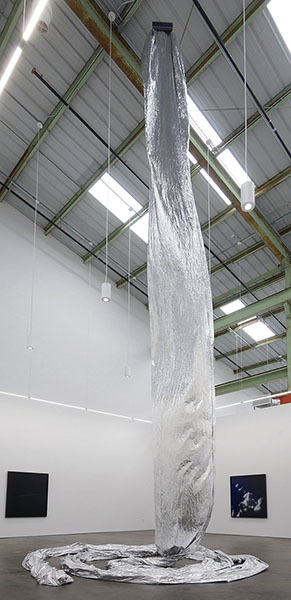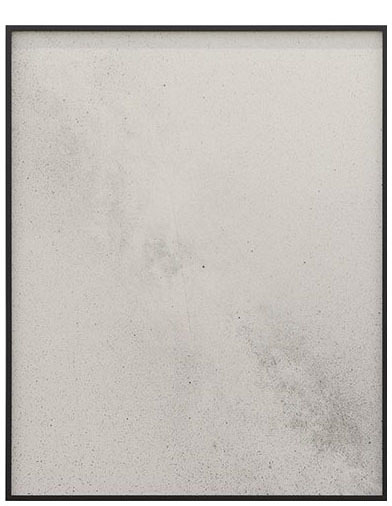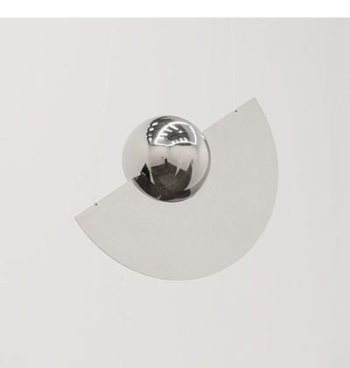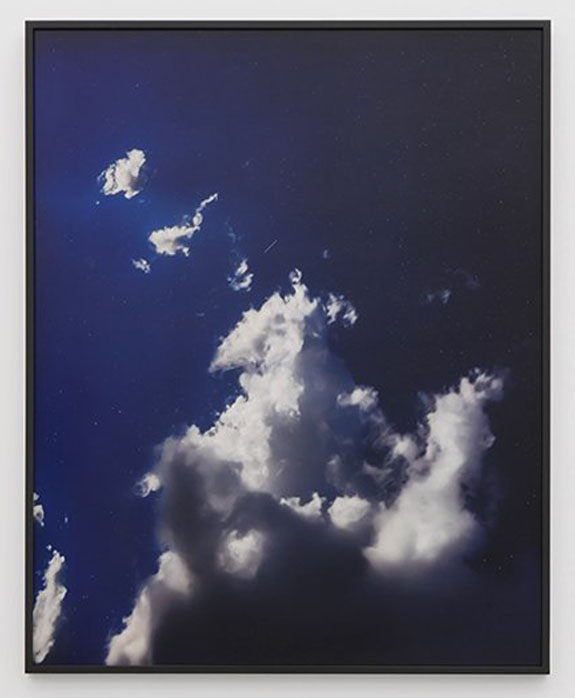by Mark Van Proyen

One of these ghostly pachyderms is the exhibition of another of Paglen’s works titled Orbital Reflector, up at the Nevada Museum of Art through the end of September. It is a mock-up for a 14-foot diameter satellite-balloon made out of reflective Mylar, which, pending an aggressive kickstarter campaign, will serve as a model for a launched piece of public art that will orbit the globe and be clearly visible in the twilight heavens. It’s stated intention is that it not have any practical function, but instead be understood as a work of aerospace engineering for the pure “esthetic” sake of aerospace engineering, thereby differentiating itself from the thousands of other fragments of space debris that float in the upper stratosphere. In Impossible Objects,there is a deflated, similarly titled iteration of the Orbital Reflector model hanging high from the ceiling, looking like a spent weather balloon from the days before satellite-based meteorology. Otherwise, it is unremarkable as anything other than a weak doppelganger for the model on display in Nevada.
The deflated Orbital Reflector model is surrounded by six large photographs featuring misty clusters of tiny dots, some sporting dark dots on light background and a few highlighting light dots on dark background. Their titles tell us that their subjects are specifically labeled satellites
There are two other clusters of works in the exhibition. One of these is a series of 23 works on 8 ½ by 11 paper that oscillate in the space between doodles and notebook sketches, all seeming to bespeak various kinds of astronomical musings that err on the side of being too cryptic to offer any real intrigue. The other is a quintet of three-dimensional works that dangle overhead. These also seem like fanciful mock-ups of unmanned spacecraft, which may or may not seem vaguely sinister, depending on how many Star Trek re-runs you can remember viewing. More to the art historical point, they seem to be honorable homages to the works of several Russian 
At the outset of this review, I made reference to two invisible elephants in the proverbial room, but I have thus far only referred to one—the deflated model of Orbital Reflector. The other is more troubling. For the past decade, Paglen has done several series of brilliant works that have interrogated the shadowy omnipresence of the post-Patriot Act National Security State, highlighting such things as Black Site airline terminals, CIA code words writ large and Predator drones flying about the twilit heavens. All of these bodies of work came off as being as serious as a heart attack, and were evidence of a particularly compelling practice that stripped the rose-colored glasses off of the duplicities of the Bush 43/Obama eras to show their hidden-in-plain-sight agendas. But now the hypocritical gloves are off and a new, even more mendacious National Security State has come to the fore, one that has traded the Deep State for Deep(er) Oligarchy, leading us to proclaim the need for a new and possibly very different kind of artistic unmasking. Maybe it is unfair to presume that, given the recent prominence of his career, Paglen would or should continue or even double-down in that vein, especially in light of what happened to Mark Lombardi just a few weeks after Bush the younger was inaugurated as POTUS 43.

For those that have not been keeping up, my reference to Lombardi points to the work and short life of an artist who gained a great deal of attention in the late 1990s for a series of drawings that were in fact forensic diagrams of the flow of dark money in and around the Bush family. In March of 2001, Lombardi was discovered to have had committed a very suspicious suicide. Those drawings are now owned by the Museum of Modern Art, but try to get the reproduction rights to any of them, and you will see that the only ones that are available are of insufficient resolution to see who or what are named in the original works. The point? Real political art is and should be a dangerous game, and if it isn’t, it’s a substitution of politicalness for politics that becomes part of the problem by substituting loyal opposition for clear and forceful critique.
What I am trying to say here is that Paglen’s new exhibition lacks the quality of pointed interrogation that animated his early work, leaving behind a collection of objects that seem all-too content to queue-up for eventual inclusion into the Kadist Foundation’s global coterie of retro-post conceptualist practices basking in the flickering limelight of the international biennial circuit. Granted, I could be wrong in this assessment, and I most sincerely hope that I am. But Paglen is too smart and too courageous an artist to loose sight of his big-picture muse so soon, so I must close here by stating my most heartfelt hope that his next series of projects will roll back my disappointment with the current exhibition.
# # #
Trevor Paglen: “Impossible Objects” @ Altman Siegel through May 3, 2018.
Cover image: Detail of “Prototype for a Non-functional Satellite (Design 4; Build 6)”
About the Author:
Mark Van Proyen’s visual work and written commentaries focus on satirizing the tragic consequences of blind faith placed in economies of narcissistic reward. Since 2003, he has been a corresponding editor for Art in America. His recent publications include: Facing Innocence: The Art of Gottfried Helnwein (2011) and Cirian Logic and the Painting of Preconstruction (2010). To learn more about Mark Van Proyen, read Alex Mak's December 9, 2014 interview, published on Broke Ass Stuart's Goddamn Website.
Great review Mark, thanks.
Nationally, less so globally, the silence is deafening. So it’s all the more unforgiveable when an artist who will be heard says nothing, or too little.